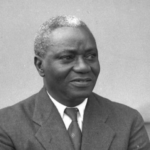MULUGETA, YEGAZU
- 3 Min Read
Ras Mulugeta Yegazu (1865-February 17, 1936) was an influential noble at the court of Emperor Menilek II [reigned 1889-1913], was one of the ministers in Menilek’s first cabinet, and was killed in 1936 while defending his country.

PHOTO CAPTION: Ras Mulugeta Yegazu SOURCE: EA Library
Ras Mulugeta came from Manz, an Amhara region of the province of Shawa. He was related to Emperor Menilek, and was a descendant of Tedu, the 18th-century ruler of Morat in northern Shawa. He fought at the battle of Adwa at which, on March 1, 1896, the Ethiopians defeated invading Italian forces and, in January 1905, became a Bajerond (treasurer and head of stores), and a confidential courier of Menilek. As minister of finance in 1908, he was a member of Menilek’s first cabinet.
Although he was later demoted by Lej Iyasu Mikael, nominal ruler of the empire from 1909-16, he was subsequently reappointed governor of Gimira, to the west of Jemma, with the title of Dajazmach, by Tassamma Nadaw (died 1911), regent of Ethiopia, who was also a relative. In 1916 he was again appointed minister of finance, and then of foreign affairs, but was dismissed from office during the disturbances of 1918, when the ministers were accused of accumulating personal wealth. He was nevertheless so influential that he sometimes mediated between the war minister. Habta Giyorgis, the regent, Ras Tafari, later to become Emperor Haile Selassie, and Empress Zawditu. He was also allowed to accompany Ras Tafari on his first European tour in 1924.
In 1926 when the minister of war, Fitawrari Habta Giyorgis, died, he was appointed to the post with the title of Fitawrari. He retained the position until his death, except for a brief period in 1931, when young Ras Beru Walda Gabriel, (thought by some to be an illegitimate son of Menilek), was appointed to that post, and he was appointed governor of Ilubabor with the title of Ras. When the Italo-Ethiopian war of 1935-36 broke out, he was again appointed minister of war, and led the main Ethiopian army in October 1935.
As war minister, Mulugeta was considered very harsh and rather conservative. He used to flog his followers. During the period before the war he was eager to fight, and urged the emperor to order mobilisation. When the emperor hesitated, and relied on diplomacy, he took the initiative, and moved northwards as commander of the corps known as the “Mahal Sarawit,” (“Army of the Center”), even though there was a shortage of transport and arms.
He alienated the peasants of Wallo, the province through which he passed to the northern war front, and during his retreat from an unsuccessful resistance, they attacked his troops. In the ensuing disorder he was separated from his men, and was killed by the Rayya tribe on February 17, 1936, at Amba Aradam, Tegre.
TSEHAI BERHANE SELASSIE




